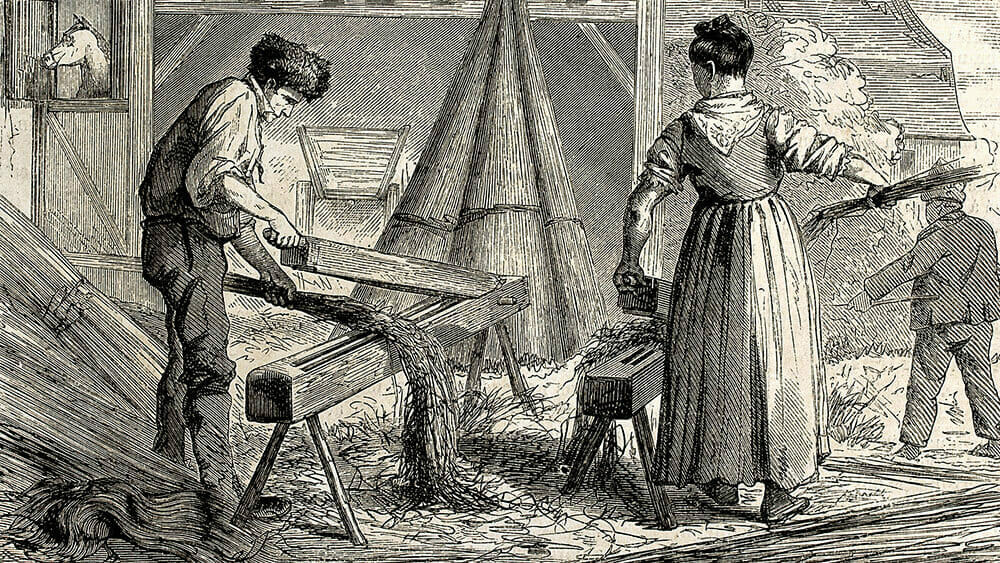History and Cultural Significance of Hemp

What is the Real History of Hemp?
Hemp has a long and storied past, rich with cultural significance around the world. From religious and ceremonial purposes to fueling the industrial complex, and eventually making its way into the multi-billion dollar CBD market, hemp has a story that is well worth the read.
With the global industrial hemp industry experiencing an explosion in growth, reaching nearly 4 billion USD globally, that story is just getting started. Understanding the history of this unique plant is important to help understand its place today and its future in science, health and wellness, and as a component of daily life.
When Was the First Recorded Cultivation of Hemp?
Although it is unclear exactly when and where hemp’s origin story began, according to both historians and archaeologists, hemp was one of the first non-food crops to be cultivated. The predominantly accepted theory is that hemp likely originated from temperate central Asia. The specifics of this origin are, however, debated.
In the Origin of Cultivated Plants (1886), DeCandolle, A. suggested that the region from which C. sativa (hemp) first came from ranged from the Caspian Sea to Lake Baikal, a massive ancient lake located in the mountainous region of Siberia.
Later, Vavilov, N. (1926) concluded that the origin of cultivated hemp was the Altai Mountains, a mountain range located in both East and Central Asia where China, Mongolia, Russia and Kazakhstan converge.
In 2000, McPartland et al. proposed that hemp cultivation stemmed from the southern Tien Shan Mountains.
Meanwhile, historians from both India and China respectively claim that hemp originated in the Himalayas or along the Yellow or Yangtze rivers.
However, the vast majority of archeological evidence supports the first widespread use of hemp as a cultivated crop in circa 4500 BC in China, with a significant amount of hemp fiber having been recovered from archaeological sites throughout China. For example, the oldest piece of hemp paper was discovered in 1957, in a tomb located in the Shaanxi Province, and dated to sometime between 140 to 87 BC.
Some archeologists contend that the hemp domestication and cultivation probably occurred across several regions in northeast Asia, dating back some six millennia ago.
It is speculated that by around 1000 BC, hemp had likely made its way west and southward as traders and nomads spread its trade across Asia Minor, India, the Middle East, Africa and Europe.
Additional Reference: https://www.cabi.org/isc/datasheet/14497
Examples of Growing and Using Hemp by Region (Asia, Europe, United States, and others)
Hemp in Egypt
In Egypt, mummies have been exhumed and found to have had hashish present in the body tissues dating back to around 1000 BC, implying that hemp was used as an herbal medicine, for religious ceremonies, and/or for recreational purposes.
Hemp in Greece and Rome
Throughout ancient Greece and Rome, hemp was a valued commodity used in the production of both coarse fabrics and clothing, as well as sacks and rope.
Hemp in Persia and Arabia
Throughout ancient Arabia and Persia, it is believed that hemp was used for recreation. The word for hemp (called hashish in Arabian) stems from the Arabian words ‘hashish al kief’, loosely translated to ‘dried herb of pleasure’.
Hemp in Ancient Iran
Ancient Iran is home to the first documented use of hemp for medicinal purposes. There it was used by the Scythians, an ancient nomadic people believed to have been of Iranian origin and spread throughout what is now Eastern European nations.
Iran was also one of the first places in the world to use hemp as a textile fiber to make cloth and clothing, with archeologists uncovering a piece of hemp cloth from what is now modern-day Iran and Iraq (ancient Mesopotamia) dating back some 10,000 years.
Hemp in Europe
Throughout Europe, the cultivation of hemp expanded throughout the 1500s-1600s, largely in response to the demand for sails and ropes in the shipping industry.
Hemp in Middle East
Similar to hemp’s uses in European history, the Middle East as a whole saw a marked demand for the use of hemp by the shipping industry for use in sails, ropes and burlap bags for the storage of grains.
Hemp in Australia and Western Africa
Throughout the 16th through 18th centuries, hemp was a vital crop for its industrious fibers used in a wide range of applications in building materials, clothing, and for many other uses.
Hemp in Taiwan
Evidence uncovered from various excavations across Taiwan have found that settlers in the area used hemp fibers in pottery dating back around 10,000 years ago.
Hemp in China
Throughout China, hemp virtually replaced the use of animal skins in making clothing. Ancient Chinese perfected the art of spinning hemp fiber into strong tactile strands used in clothing and other textiles, substantiated in the ancient Chinese text “Book of Rights’ written in second century BC. While silk (produced by silkworms) was the preferred material for clothing for the upper classes, it was too expensive for commoners, who turned to hemp for their clothing instead.
Hemp in India
Hemp is considered sacred in Hindu religious texts, where it is referred to as “sacred grass,” one of the five sacred plants of India. In India, hemp was used to make Bhang, a type of drink made from a mixture of water, spices, yogurt, milk, and cannabis flowers and leaves. In ancient India, this hemp-infused drink was akin to alcohol’s use in the West, and was a pivotal aspect of both religious and social occasions.
Hemp History in the United States
In the United States, hemp production has been a controversial topic for many decades, but the plant itself has been grown for thousands of years, with some discovered items using hemp dating back as far as 10,000 or more years ago.
Colonists in the U.S. grew hemp for textiles and rope. However, in the 20th century, political and racial factors led to marijuana's criminalization in the United States. It is only recently though that its legal status has rapidly evolved with many jurisdictions at the state level having legalized its use for medical and/or recreational purposes. Similarly, the U.S. federal government has legalized the use of industrial hemp for use in a wide range of applications so long as certain regulatory requirements are met.
This evolution in the acceptance of hemp as a high-value crop has resulted in hemp reclaiming its place as a driving force in the United States' agricultural industry.
Hemp and America's Founding Fathers
Hemp has been cultivated in the United States since even before its settlement by Europeans. Several of America's Founding Fathers grew hemp on their land, including George Washington and Thomas Jefferson.
During the 1600s, farmers in Virginia, Massachusetts and Connecticut were required by law to grow hemp because it was considered such a necessary raw component needed for use in a wide variety of products. In the 1700s, bounties and subsidies were used to encourage farmers to grow hemp in lieu of other crops.
During this time period, hemp was valued for use in fabric, rope and paper, among other common items. It was such a valued commodity that some farmers even used hemp crops to pay their levies and taxes.
FUN FACT: The Declaration of Independence was written on paper made from hemp.
19th Century Hemp Production
As the nation expanded, hemp growing spread throughout the land. By the beginning of the 19th century, hemp had become a major cash crop in a several states, with Kentucky, Illinois and Missouri leading the charge.
Until the late 1800s, demand for hemp soared. However, the rising popularity of steamships meant an end to the demand for the hemp used in sails. However, hemp was still widely grown for its use in ropes and rigging.
Kentucky was the only remaining state with a robust hemp industry prior to WWI. During WWI, increased demand in hemp production sparked a surge in hemp production in Kentucky, as well as a resurgence in several states that had previously stopped cultivating the crop. This increased demand was bolstered by the development of mechanical hemp harvesting which made hemp production significantly more efficient.
What Was the Path of Hemp From Just Before Prohibition to Current Legal Status?
The Marijuana Tax Act of 1937
Although hemp production in the United States steadily declined during the years leading up to 1937 for several reasons, none was as impactful a catalyst as was the Marijuana Tax Act of 1937.
This act, intended to put a damper on marijuana use as a recreational drug, effectively put the handcuffs on the industrial hemp industry as well. Its passing into law put hemp under the watchful oversight and regulation of the Department of Revenue. Industrial hemp farmers who wished to continue business as usual were now required to pay a hefty tax.
Hemp’s Status in the USA Today
Overcoming significant adversity and complicated laws, hemp has made a hero’s comeback in the United States. This comeback has been driven largely by the surging popularity of CBD, the legalization and decriminalization of marijuana / industrial hemp at the state level, and the passing of the 2018 Farm Bill.
Where is Industrial Hemp Grown Today and Who are the Main Exporters?
Hemp Production in The People’s Republic of China (China)
According to the United States Department of Agriculture, China’s hemp industry has ‘exploded’ in recent years. Despite being banned from 1985 to 2010, the country is now the largest producer of hemp fiber in the world, cultivating nearly half of the world’s hemp fiber supplies.
Industry estimates from China indicate that the country planted 164,819 acres of hemp in 2019 - more than half of which was for fiber.
Hemp Production in Canada
Health Canada reported in its most recent disclosure (2018) that the country had 77,800 acres of industrial hemp, with 15% in Manitoba (11,500 acres), 35% in Saskatchewan (27,100 acres), and 38.5% in Alberta (30,000 acres) respectively.
Hemp Production in the USA
As of 2020, the licensed hemp industry in the United States totaled just 465,787 acres, reported by some 47 individual state departments.
Leading the production are:
- Kentucky
- Colorado
- Oregon
- North Dakota
- Minnesota; and
- New York
Hemp Production in France
Having nearly doubled the production of hemp crops over the last few decades, as of 2017 it was reported that the country boasted over 43,000 acres of hemp fields.
Hemp Production in Columbia
Columbia’s evolving laws have recently favored the cultivation of hemp, making a distinction between psychoactive cannabis high in THC, and low THC non-psychoactive industrial hemp. Farmers are now adapting fields to grow hemp, taking advantage of the unique climate, enabling them to harvest up to 3-4 crops annually.
Hemp Production in Lithuania
In 2020, Lithuania increased its industrial hemp production, outpacing Germany by nearly double, and becoming a regional leader in the E.U. with over 22,680 acres.
Hemp Production in Germany
Germany has increased its hemp farms to the highest levels since the legalization of the crop in 1996. Currently, the country boasts 6,444 hectares.
Hemp Production in North Korea
A surprising addition to this list, North Korea cultivates and utilizes hemp at the industrial level, having dedicated an estimated 47,000 square meters of land for hemp textiles in Pyongyang alone.
What is the History of Smoking Hemp?
Throughout history, mind-altering, as well as non-psychoactive herbs and plants have played an important role in ritual and/or religious activities in various areas of the world.
Across Central Eurasia and around the world, several plants, including Cannabis Sativa, were and are still smoked to this day.
Historically, Cannabis S. (including hemp and marijuana) have been smoked for medicinal, ritual, spiritual, and ceremonial purposes. Smoking pipes are thought to have originated in the New World, where they spread to Eurasia. Despite being the seat of hemp cultivation for fiber and textiles, prior to the modern era no definitive evidence has been found that smoking hemp from pipes existed in Central Asia during that time.
The practice of smoking hemp/cannabis for both recreational as well as ceremonial and ritual practice has been documented as far back as the 5th century BC. The first documentation of such activity was found in Herodotos’ The Histories. This discovery was later supported by evidence of carbonized hemp seeds found in burial sites around Eurasia.
Phytochemical analysis of cannabis plant debris found in wooden braziers used for mortuary ceremonies at the Jirzankal Cemetery (500 BCE) further suggested that hemp and/or cannabis was used as part of religious and ritual activity throughout western Chinese provinces some 2500 years ago.
These studies have linked hemp’s use to populations in what we know as modern Afghanistan, Tajikistan and regions of China.
How and When Did CBD Become Popular in the US?
Despite being discovered in 1940, it wasn’t until the last decade or two that cannabidiol (CBD) really took off in popularity within the USA.
But was what was the catalyst that sparked demand for what is now a thriving industry worth more than $1 billion annually in the United States?
In the mid-2000s, an infant in Colorado named Charlotte Figi was placed squarely in the media’s spotlight. Charlotte suffered from Dravet Syndrome, a debilitating epileptic disorder.
Pulling on the nation’s heartstrings, her story and use of cannabis oil to treat the disorder put a face on the potential of CBD and cannabis oils as a wellness aid. It turned out that with the use of a specially prepared cannabis oil (CBD), the child’s seizures dropped from a staggering 300 per week, to less than five per month.
'Big Pharma', ever the capitalist, took notice, with British biotech company GW Pharmaceuticals eventually bringing the first FDA-approved CBD drug to market (Epidiolex®).
With American customers now aware and interested in exploring non-psychoactive cannabinoids as a potential health aid, the market was ripe for growth… but with one major hindrance: hemp production was still largely prohibited across the United States.
In 2018, the passing of the 2018 Farm Bill fully legalized the production of industrial hemp (with certain stipulations and regulatory restrictions and requirements), opening up the doors for mass production.
Since then, the industry has experienced a flood of hemp-derived products.
What is the Projected Future of the CBD & Hemp Market?
The Future Looks Bright for CBD and Hemp
According to analysts, the global hemp industry was valued at around $3.61 Billion USD in 2020 with an annual compound growth rate expected to hit 16.2% between 2021 to 2028. Similarly, the global CBD market is projected by some to reach nearly $20 billion globally by 2025, including everything from CBD infused beauty products to drinks, food, and supplements.
MOUNTAIN Smokes®
ZERO TOBACCO. ZERO NICOTINE. Premium Organic Full-Flower Hemp Smokes.
 SHOP MOUNTAIN SMOKES
SHOP MOUNTAIN SMOKES
 Made in the USA
Made in the USA
 Satisfaction Guaranteed
Satisfaction Guaranteed
 SSL Secure Checkout
SSL Secure Checkout


